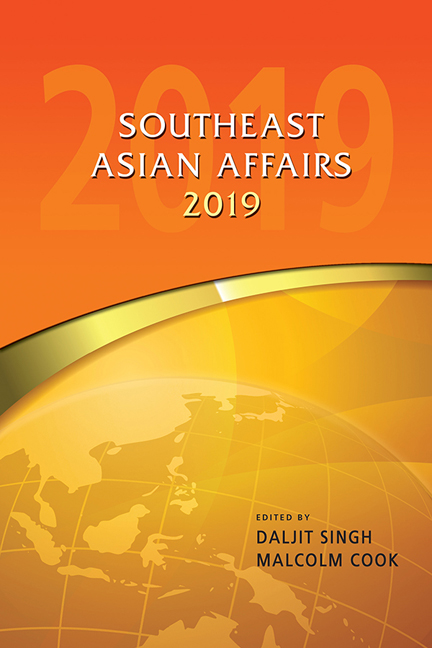Book contents
- Frontmatter
- Contents
- Introduction
- THE REGION
- Challenges to Southeast Asian Regionalism in 2018
- Regional Integration in Asia and the Pacific, and Dealing with Short and Long Term Challenges
- Looking West, Acting East: India's Indo-Pacific Strategy
- An Australian Vision of the Indo-Pacific and What It Means for Southeast Asia
- The Trump Administration's Free and Open Indo-Pacific Approach
- Japan's “Free and Open Indo-Pacific Strategy” and Its Implication for ASEAN
- BRUNEI DARUSSALAM
- CAMBODIA
- INDONESIA
- LAOS
- MALAYSIA
- MYANMAR
- THE PHILIPPINES
- SINGAPORE
- THAILAND
- TIMOR-LESTE
- VIETNAM
Regional Integration in Asia and the Pacific, and Dealing with Short and Long Term Challenges
from THE REGION
Published online by Cambridge University Press: 07 September 2019
- Frontmatter
- Contents
- Introduction
- THE REGION
- Challenges to Southeast Asian Regionalism in 2018
- Regional Integration in Asia and the Pacific, and Dealing with Short and Long Term Challenges
- Looking West, Acting East: India's Indo-Pacific Strategy
- An Australian Vision of the Indo-Pacific and What It Means for Southeast Asia
- The Trump Administration's Free and Open Indo-Pacific Approach
- Japan's “Free and Open Indo-Pacific Strategy” and Its Implication for ASEAN
- BRUNEI DARUSSALAM
- CAMBODIA
- INDONESIA
- LAOS
- MALAYSIA
- MYANMAR
- THE PHILIPPINES
- SINGAPORE
- THAILAND
- TIMOR-LESTE
- VIETNAM
Summary
In the last few decades, Asia and the Pacific has established itself as a formidable economic force that has proven remarkably resilient to difficulties, weathering both the Asian financial crisis in 1997 and the global financial crisis (GFC) in 2008. While countries elsewhere on the globe continue to struggle to shake off the worst effects of the 2008 GFC, Asia and the Pacific has continued to prosper and post gains in economic growth and poverty eradication.
Coming into 2018, the outlook for the region was largely optimistic. Early in the year, the global trade slowdown, which started around 2010, appeared to have begun bottoming out, with East and Southeast Asia in particular leading the recovery. Export growth in the second half of 2017 reached 7.9 per cent in the People's Republic of China (PRC) and 16.5 per cent in the five largest ASEAN economies: Indonesia, Malaysia, the Philippines, Thailand and Vietnam. That Asia and the Pacific managed to achieve this in the midst of growing protectionism elsewhere speaks volumes about the region's commitment to regional and global integration.
Unfortunately, more recent data suggests that the recovery in global trade may have been short-lived. With growth expected to ease in some advanced economies, the growth in world trade is projected to decline slightly from 4.7 per cent in 2017 to 4.5 per cent in 2018. In developing countries in Asia and the Pacific, trade volume growth is also projected to ease from the estimated 7.6 per cent in 2017 to 5.5 per cent in 2018.
Moreover, although the economic outlook for the region in 2018 and 2019 remains somewhat favourable, downside risks are on the rise. The Asian Development Bank (ADB) still expects developing countries in the region to hit 6 per cent growth this year, but it has trimmed the forecast for 2019 by 0.1 percentage points to 5.8 per cent.
A number of critical changes are afoot. Many of the favourable conditions that have helped fuel the region's successes may not hold in the short-term, while emerging trends such as population ageing and the fourth industrial revolution (4IR) bring with them new long-term opportunities as well as challenges.
- Type
- Chapter
- Information
- Southeast Asian Affairs 2019 , pp. 21 - 42Publisher: ISEAS–Yusof Ishak InstitutePrint publication year: 2019

